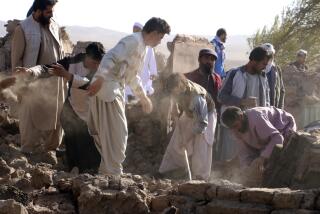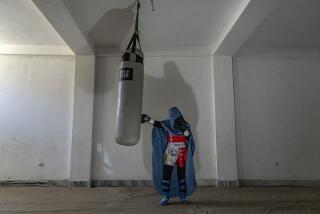Empty American Promises Embitter an Afghan Village
DARA-I-SUF, Afghanistan — One icy night in mid-October, a U.S. military advisor who called himself “Baba John” rounded up villagers in this guerrilla fighters’ paradise and asked them what they wanted when the war was over.
A school. A clinic. Roads that wouldn’t turn to mud when it rained. Pens. Pencils. Grain.
“Baba John offered so many things,” recalls Azim Naim Zada, a community elder. “He told us that if we fought hard against the Taliban, we’d get so much food we’d grow fat, like him.”
The villagers did fight hard, and helped drive the Taliban out of this rocky canyon about 75 miles south of Mazar-i-Sharif. It was a key battle in the ground war leading to the capture of the strategic northern city, and it triggered a Taliban retreat across the country.
But five months later, the people here are still hungry. Waiting.
Their fields are a sandy, seedless, unplowed mess, so heavily mined that people are too frightened even to venture out to bury the bones scattered around.
At night, as they huddle over steaming bowls of grass soup, they listen to wild dogs prowling the hills, looking for corpses.
Many houses have been reduced to crumbled mud, some by Taliban shells, villagers say, but others by American bombs.
After 23 years of war, Afghanistan has heaps of misery stories. But this one, buried in an inaccessible region where few foreigners go, has a hint of betrayal to it.
When Dara-i-Suf, “The Valley of Caves” in the Dari language, became a center of anti-Taliban resistance at the beginning of the war, villagers made sure that “Baba John” and the other Special Forces troops had the best caves, along with rugs to line them and make them comfortable.
The locals volunteered as soldiers, translators, guides and cooks. The Americans liked the kebabs, many remember.
But U.S. military officials have no plans to return to Dara-i-Suf, or to send help. Of the 65 humanitarian aid projects underway or proposed by the military for northern Afghanistan, none involve this area.
“I’d imagine Special Forces would say whatever they needed to, to win cooperation from locals,” said Maj. Martin Rose, an Army civil affairs officer based in Mazar-i-Sharif. “That doesn’t mean we’re going down there.”
Military officials wouldn’t discuss details of Special Forces tactics, but several said it was basic strategy during the war’s early days to offer aid assurances.
The Army civil affairs office has deployed more than a dozen soldiers in Afghanistan to fix generators, rebuild schools and open fire stations. But most projects are in larger cities such as Kabul, Kunduz and Mazar-i-Sharif.
Dara-i-Suf is a string of little settlements stretched in canyons between 1,000-foot rock walls where light barely reaches. There are no roads in or out, just icy rivers to slog through. Few aid agencies work here, despite food shortages and illness, including a disease local people call “black leg,” which cuts off circulation and hobbles hundreds of people.
During the last three years of Taliban rule in Afghanistan, Dara-i-Suf served as a refuge for the anti-Taliban Northern Alliance. After the Taliban captured Mazar-i-Sharif in August 1998, 5,000 Northern Alliance troops, including top commanders, retreated here.
The Taliban swept after them, taking over mountain ridges and shelling the village below. They raided homes, cut down almond trees, stole sheep and butchered civilians.
“They turned me into a beggar,” said one widow, Jumabegom, whose husband was shot and hacked into pieces.
The Taliban also burned down the market, once the pride of the valley, a 600-stall bazaar of pelt shops, blacksmiths, bookstores and cafes.
However, the momentum turned when U.S. Special Forces soldiers arrived after the Sept. 11 terrorist attacks.
U.S. military officials wouldn’t discuss the operation, except to say that Special Forces troops worked closely with Northern Alliance leaders in the area. But several Afghan commanders said that two helicopters landed in a canyon near Dara-i-Suf one night in mid-October and that eight U.S. advisors stepped out.
More arrived during the next week to plan an air and ground assault on the hundreds of mountainside Taliban bunkers that formed the front line. The lead American advisor, villagers say, was a thick man who appeared to be about 50 years old, didn’t carry a gun and always introduced himself as “Baba John.” Baba means grandfather.
“Everybody knew Baba John,” said Esmatullah Ahmadi, an Alliance commander. “He used to walk through the villages, saying to the people, ‘Tashakor, tashakor,’ ” meaning “Thank you, thank you.”
“He promised big bags of grain and rugs for our schools,” Ahmadi said.
Residents say that when the attacks began, several villages near the front line were flattened by U.S. bombs, including Balooch, where they say 45 civilians were killed.
“Some of us were lucky and hid in caves,” said Mohammed Nabi, a Balooch elder. “But the others”--he clapped his chalky hands together once--”crushed.”
Col. Rick Thomas, a spokesman for the U.S. Central Command, said American warplanes repeatedly bombed the area. There was no information on civilian casualties, he said.
Despite hundreds of Northern Alliance casualties, the offensive overwhelmed the Taliban forces, pushing them back to Mazar-i-Sharif and then east to Kunduz, where thousands of Taliban members surrendered.
Many Alliance leaders remember Dara-i-Suf as a turning point--the place, as commander Haji Wahab put it, where “the Taliban melted.”
The mountaintops still glisten with the litter of war: shells, bullet casings, bleached bones of fallen soldiers and thousands of foil wrappers from airdropped food rations.
“We were expecting more,” a former soldier, Rhoullah, said as he stepped over a Pop-Tarts package, a strangely common sight here.
A mile away, a sinewy man pressed ahead with two donkeys and a plow. He turned around abruptly when he reached something shiny on the hillside, leaving a conspicuous unplowed patch. Unexploded bombs and mines are big problems here. Last week, a shepherd was killed chasing a sheep.
Although the British de-mining agency HALO Trust has removed 7,477 mines from northern Afghanistan this year, no technicians have been to Dara-i-Suf, so it remains too dangerous for aid providers.
Most Northern Alliance leaders who lived in the caves and fought in the canyons haven’t been back either, including Haji Mohammed Mukhaqiq, now the planning minister for the interim government in Kabul, the capital.
In an interview, Mukhaqiq said he had been busy with government business and expressed regret that he hadn’t done more to help Dara-i-Suf residents.
“Man forgets soon,” he said, quoting a Persian saying.
The other day, Jumabegom, the widow, insisted on boiling her last chicken for a guest.
While she was tending the pot, her 3-year-old son bolted into the yard.
“Tayara! Tayara!” (“A helicopter! A helicopter!”), the little boy yelled as the rumble of a heavy engine grew louder, perhaps signaling the arrival of foreigners. But it was just an old truck hauling dirt, struggling over rocks in the river.
More to Read
Sign up for Essential California
The most important California stories and recommendations in your inbox every morning.
You may occasionally receive promotional content from the Los Angeles Times.










